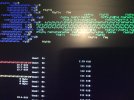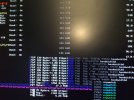After changing screen resolution to more night (640x480 text -> 1600x1200 graphics), output from btop app (formerly bpytop on-screen real-time monitoring tool) look like mess (see attached screen photos).
The same behavior for current btop app and for previous version - bpytop.
Only one exception: btop not start (display ERROR: No UTF-8 locale detected) automatically, and able to start only with key —utf-force that ignore UTF compability locale detection.
[UPDATE]
Other monitoring utility “gotop” have the same behavior: mess on a local-attached screen (ttyv0).
How to fix this ? May be directly pointing on specific UTF-8 font in /boot/loader. conf.local ?
btop on GitHub - https://github.com/aristocratos/btop
Let’s bring You attention to next from app description:
#####################
See Terminess Powerline for an example of a font that includes the braille symbols.
See comments by @sgleizes link and @XenHat linkin issue #100 for possible solutions.
If text are misaligned and you are using Konsole or Yakuake, turning off "Bi-Directional text rendering" is a possible fix.
Characters clipping in to each other or text/border misalignments is not bugs caused by bpytop, but most likely a fontconfig or terminal problem where the braille characters making up the graphs aren't rendered correctly. Look to the creators of the terminal emulator you use to fix these issues if the previous mentioned fixes don't work for you.
##########
Right now I have
In /boot/loader.conf.local
...
mga_load="YES"
kern.vty=sc
kern.vt.fb.default_mode=“1600x1200”
vbe_max_resolution="1600x1200"
...
And I make corrections in /etc/login.conf to enable UTF-8 systemwide (based on this tread https://forums.freebsd.org/threads/system-wide-utf-8.54388/):
defaults:\
:charset=UTF-8:\
:lang=en_US.UTF-8:\
:setenv=LC_COLLATE=C:\
:umask=022:
If this corrections in /etc/login.conf not enough may be better to make how described in this https://www.b1c1l1.com/blog/2011/05/09/using-utf-8-unicode-on-freebsd/ article ?
The same behavior for current btop app and for previous version - bpytop.
Only one exception: btop not start (display ERROR: No UTF-8 locale detected) automatically, and able to start only with key —utf-force that ignore UTF compability locale detection.
[UPDATE]
Other monitoring utility “gotop” have the same behavior: mess on a local-attached screen (ttyv0).
How to fix this ? May be directly pointing on specific UTF-8 font in /boot/loader. conf.local ?
btop on GitHub - https://github.com/aristocratos/btop
Let’s bring You attention to next from app description:
#####################
Linux, Mac Os X and FreeBSD
For correct display, a terminal with support for:- 24-bit truecolor (See list of terminals with truecolor support)
- 256-color terminals are supported through 24-bit to 256-color conversion when setting "truecolor" to False in the options or with "-lc/--low-color" argument.
- Wide characters (Are sometimes problematic in web-based terminals)
- Unicode Block “Braille Patterns” U+2800 - U+28FF
- Unicode Block “Geometric Shapes” U+25A0 - U+25FF
- Unicode Block "Box Drawing" and "Block Elements" U+2500 - U+259F
Notice (Text rendering issues)
If you are having problems with the characters in the graphs not looking like they do in the screenshots, it's likely a problem with your systems configured fallback font not having support for braille characters.See Terminess Powerline for an example of a font that includes the braille symbols.
See comments by @sgleizes link and @XenHat linkin issue #100 for possible solutions.
If text are misaligned and you are using Konsole or Yakuake, turning off "Bi-Directional text rendering" is a possible fix.
Characters clipping in to each other or text/border misalignments is not bugs caused by bpytop, but most likely a fontconfig or terminal problem where the braille characters making up the graphs aren't rendered correctly. Look to the creators of the terminal emulator you use to fix these issues if the previous mentioned fixes don't work for you.
##########
Right now I have
In /boot/loader.conf.local
...
mga_load="YES"
kern.vty=sc
kern.vt.fb.default_mode=“1600x1200”
vbe_max_resolution="1600x1200"
...
And I make corrections in /etc/login.conf to enable UTF-8 systemwide (based on this tread https://forums.freebsd.org/threads/system-wide-utf-8.54388/):
defaults:\
:charset=UTF-8:\
:lang=en_US.UTF-8:\
:setenv=LC_COLLATE=C:\
:umask=022:
If this corrections in /etc/login.conf not enough may be better to make how described in this https://www.b1c1l1.com/blog/2011/05/09/using-utf-8-unicode-on-freebsd/ article ?



